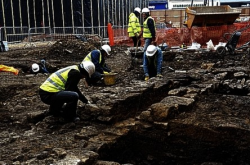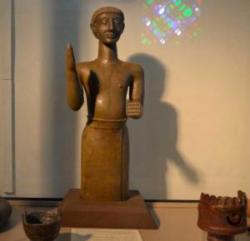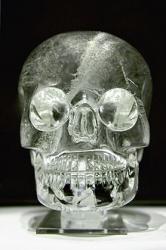INSTITUT SUPERIEUR D'ANTHROPOLOGIE
INSTITUTE OF ANTHROPOLOGY
ONLINE COURSES / COURS A DISTANCE
SPRING SESSION : APRIL 2013
REGISTER NOW
ROYAUME UNI –  Lincoln - On the surface it looks like any other high street but buried under the feet of Lincoln's shoppers lies an exciting piece of medieval history. For while cash tills have been ringing, archaeologists have been busy uncovering a road 6ft below the city centre. The 9ft-wide rubble track runs from the High Street towards Brayford Pool which, during medieval times, reached further inland. And from the deep ruts left by cartwheels it appears the lane was once a busy trade route serving a thriving port. The dig has also revealed 26ft long wall foundations, possibly from a medieval store or warehouse. Chris Clay, director of Allen Archaeology, based in Branston, believes both finds date from the 14th century. "This street would have been quite hemmed in by buildings on either side," he said. "It would probably have been like that narrow passageway a bit further down off the High Street – Swanpool Court – but a little wider. A medieval town was generally quite filthy – people threw their waste into the main streets – so this little lane would have been worse. "You can imagine houses and shops all along the front of the High Street in the medieval period. The building is on a slightly different alignment to the buildings in the High Street now. "It is at the back of the site, off the High Street, so it's more likely to be an outbuilding. "The question really is was this building associated with what was happening on the High Street or whether it was a warehouse or store associated with the Brayford? "We know the road has been in use for a long time but until we can properly date pottery finds from the site we cannot give it a lifespan. "Someone could have built across the road meaning that it didn't go anywhere, or it could have been closed off on the High Street."
Lincoln - On the surface it looks like any other high street but buried under the feet of Lincoln's shoppers lies an exciting piece of medieval history. For while cash tills have been ringing, archaeologists have been busy uncovering a road 6ft below the city centre. The 9ft-wide rubble track runs from the High Street towards Brayford Pool which, during medieval times, reached further inland. And from the deep ruts left by cartwheels it appears the lane was once a busy trade route serving a thriving port. The dig has also revealed 26ft long wall foundations, possibly from a medieval store or warehouse. Chris Clay, director of Allen Archaeology, based in Branston, believes both finds date from the 14th century. "This street would have been quite hemmed in by buildings on either side," he said. "It would probably have been like that narrow passageway a bit further down off the High Street – Swanpool Court – but a little wider. A medieval town was generally quite filthy – people threw their waste into the main streets – so this little lane would have been worse. "You can imagine houses and shops all along the front of the High Street in the medieval period. The building is on a slightly different alignment to the buildings in the High Street now. "It is at the back of the site, off the High Street, so it's more likely to be an outbuilding. "The question really is was this building associated with what was happening on the High Street or whether it was a warehouse or store associated with the Brayford? "We know the road has been in use for a long time but until we can properly date pottery finds from the site we cannot give it a lifespan. "Someone could have built across the road meaning that it didn't go anywhere, or it could have been closed off on the High Street."
http://www.thisislincolnshire.co.uk/hidden-medieval-road-linked-Lincoln-thriving-port/story-18334840-detail/story.html#axzz2MsL3lrQX
INDONESIE – Baturaja - Indonesian archeologists have planned to conduct excavation again in a cave in South Sumatra of the country in April as they predict there are still many prehistoric neo-mongoloid human bones in the cave, an official said on Monday. A national archeologist team had conducted four excavations in Tiger Cave, Baturaja, Ogan Komering Ulu District, and unearthed prehistoric relics in the site, head of Ogan Komering Ulu Tourism Office Aufa Sarkomi said in South Sumatra. "During the last two months, the national archeologist team had done four excavations and will continue the dig in April as hundreds of prehistoric neo-mongoloid human bones are predicted still buried with relics inside the cave," he said, quoted by the Antara news wire. The archeologists had found some cave paintings, funnel axes, ceramics, burial objects and 66 human bones after they dug three meters deep during the previous excavation. According to the archeologists, the structures of the relics indicated that the cave was once inhabited by prehistoric human of the neo-mongoloid race and the location also became a mass grave in 3,000 year ago, Sarkomi said. The found relics would be well preserved and the authorities would develop Harimau Cave, located in Putri Cave natural tourism complex of Baturaja, as one of the main tourism destination.
http://www.kaogu.cn/en/detail.asp?ProductID=3924
YEMEN –  - Over the past seven years, around 1,500 antiques—including coins, and pre-Islamic stone carvings—have been confiscated at Sana’a International Airport. Smugglers have been tucking these ancient artifacts inside clothing and hiding them in bags, hoping to sell them abroad. None of the items have been dated yet. Once the antiquities arrive in the museum, each piece will be assessed.
- Over the past seven years, around 1,500 antiques—including coins, and pre-Islamic stone carvings—have been confiscated at Sana’a International Airport. Smugglers have been tucking these ancient artifacts inside clothing and hiding them in bags, hoping to sell them abroad. None of the items have been dated yet. Once the antiquities arrive in the museum, each piece will be assessed.
http://www.yementimes.com/en/1657/news/2091/Smugglers-thwarted-at-airport-ancient-artifacts-headed-to-museum-in-Sana%E2%80%99a.htm
MEXIQUE –  - They may have gained fame in the Steven Spielberg adventure film "Indiana Jones and the Kingdom of the Crystal Skull," but those quartz-crystal skulls that once ranked as a great enigma of archaeology are certifiably fake. And the current edition of Chemical & Engineering News, (C&EN) the weekly news magazine of the American Chemical Society, the world's largest scientific society, recalls the details of their rise and fall. In the article, Sarah Everts, C&EN's European science correspondent, delves back into history, explaining that the skull sculptures — supposedly crafted before the Spanish conquest in the 16th century — began appearing on the art market in the 1860s. They graced collections of institutions as renowned as the British Museum in London, the Quai Branly Museum in Paris and Washington, D.C.'s Smithsonian Institution. Experts began doubting the authenticity of the skulls as long ago as the 1930s. Everts describes how experts at those three museums have used scientific instruments to show that the skulls are post-Columbian fakes. French antiquities dealer Eugène Boban played a major role in sparking public fascination with the skulls by getting some of the first fakes placed in major museums.
- They may have gained fame in the Steven Spielberg adventure film "Indiana Jones and the Kingdom of the Crystal Skull," but those quartz-crystal skulls that once ranked as a great enigma of archaeology are certifiably fake. And the current edition of Chemical & Engineering News, (C&EN) the weekly news magazine of the American Chemical Society, the world's largest scientific society, recalls the details of their rise and fall. In the article, Sarah Everts, C&EN's European science correspondent, delves back into history, explaining that the skull sculptures — supposedly crafted before the Spanish conquest in the 16th century — began appearing on the art market in the 1860s. They graced collections of institutions as renowned as the British Museum in London, the Quai Branly Museum in Paris and Washington, D.C.'s Smithsonian Institution. Experts began doubting the authenticity of the skulls as long ago as the 1930s. Everts describes how experts at those three museums have used scientific instruments to show that the skulls are post-Columbian fakes. French antiquities dealer Eugène Boban played a major role in sparking public fascination with the skulls by getting some of the first fakes placed in major museums.
http://www.eurekalert.org/pub_releases/2013-03/acs-hsd030713.php